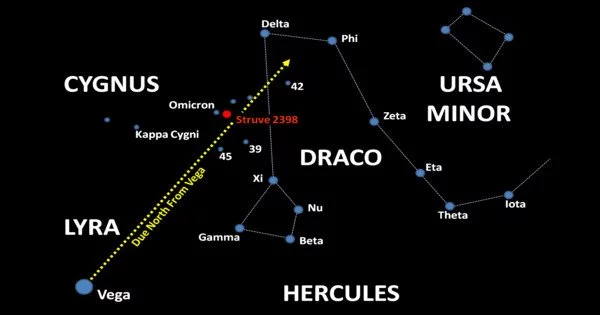Struve 2398 is a binary star system in Draco’s northern constellation. Struve 2398 is star number 2398 in Baltic-German astronomer Friedrich Georg Wilhelm von Struve’s Struve Double Star Catalog. A Greek sigma Σ, represents the astronomer’s surname, and thus the star identifier. Despite the fact that the components are too faint to be seen with the naked eye, this star system is one of the closest to the Sun. The Hipparcos spacecraft’s parallax measurements put them at a distance of about 11.6 light years.
Struve 2398 is a binary star system made up of two red dwarfs located 11.5 light-years away in the northeast part of Draco (R.A. 18h 42.8m, Dec. +59° 37.8′), northeast of Xi Draconis and southwest of Delta Dra. Both stars are small red dwarfs, about one-third the mass and radius of the Sun. Struve 2398 A has been designated as a New Suspected Variable with the designation NSV 11288, while Struve 2398 B is a flare star. They all exhibit the type of variability seen in flare stars, and their active surfaces emit X-rays.

The pair’s proper motion is relatively fast, at 2.2 arc seconds per year. The system is traveling through the Milky Way on an eccentric orbit with an eccentricity of 0.05, taking them as close as 8 kpc and as far as 9 kpc from the Galactic Center. Their galactic orbit plane takes them as far as 463 489 pc away from the galactic plane. The orbit of the system has a period of 408 years and an eccentricity of 0.53, resulting in an average separation between the stars of 56 astronomical units (AU) and a range of 26–86 AU.
Planetary system
A planet candidate with a 2.7-day orbit around Struve 2398 B was proposed in 2016, but the signal was found to be comparable with an instrumental noise floor. Two candidate planets were detected in orbit around component B in 2019 using the radial velocity method, but the previous candidate was not detected.
Struve 2398 A and B are two stars that orbit each other at a “average” distance of about 56 times the Earth-Sun distance (42 astronomical units (AUs) of an orbital semi-major axis), which is roughly Pluto’s orbital distance in the Solar System.
















